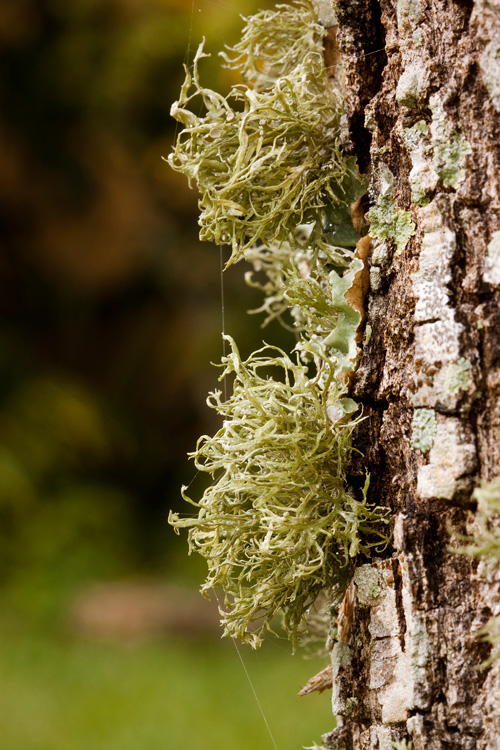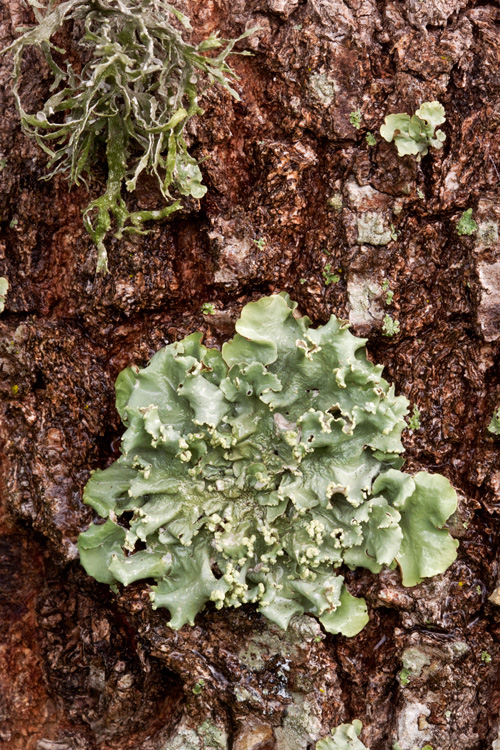Leave that lichen alone

BY KENNETH SETZER
As published in the Miami Herald, 10/10/14.
A LICHEN TAKES CARE OF ITSELF, AND IS NOT A PARASITE. IT DOES NO HARM TO YOUR TREES. IN FACT, IT CONTRIBUTES TO THE NITROGEN CYCLE AND IS OFTEN THE PIONEERING LIFE FORM IN DIFFICULT ENVIRONMENTS.
Some folks think lichen is bad for their trees. Those people can be spotted standing out in the hot sun picking little gray-green tufts off their tree trunks like a woodpecker hunting for bugs. But it’s completely unnecessary. Lichen is unequivocally harmless. But what exactly is it?
It’s easy to write a lot of bad puns using the word lichen, but a little harder to explain what it actually is. It’s not a plant, nor is it a fungus. It’s both — kind of. Sometime in the incomprehensibly distant past, a fungus and a cyanobacterium (also called blue-green algae) decided they were stronger together than apart, much like a human couple, so they formed a union. This symbiotic relationship formed what we call lichen.
So lichen is really two species — and sometimes more, with an additional alga. Nature is truly stranger than fiction. Each partner uses its own strengths in the relationship: The fungus can break down and extract nutrients from matter that the cyanobacterium cannot and can also build the “house” for this pairing in the form of the structure we see (called the thallus), while the cyanobacterium can photosynthesize and contribute energy to the union in its own, plantlike way.
A close look at a tree trunk reveals a world mostly ignored — by people anyway. Spend a few minutes up close with a live oak trunk, and you will see two or three kinds of airplants like Tillandsia, multiple types of lichen, insects and spiders of course, and any number of life-and-death dramas playing out before your very eyes. You may not view lichen as part of any wild drama, but it is, although on a pretty slow pace.
Lichen usually grows on something else, like a tree (making it an epiphyte) or rock (an epilith). I can’t think of any other organism that can survive on bare rock. If it’s variety you seek, lichen not only comes in many forms, but in colors like chartreuse, stark white, red, yellow, orange and of course green.
There are even lichens that don’t need to attach to anything. Called erratic or vagrant lichen, these drifters thrive almost anywhere. After a disaster, like a volcanic eruption or landslide, lichen is likely to be among the pioneers of the new landscape. Lichen can even break down solid rock by accumulating bits of acidic organic matter and retaining moisture from acidic rainfall, which over time — don’t plan on watching this personally — decomposes the stone back into the soil.
Lichen presents a bit of a conundrum as far as scientific naming goes, since it is the result of two or more species cohabitating as one. They form something new, yet are still clearly separate. Conventionally, lichens are named based on the fungal member of the relationship. This can lead to problems though. If the fungus involved pairs with a different alga, a completely different-looking lichen will result. However under this system it will still be named for the fungus. But no matter. It’s a bit difficult to identify species anyway.
The three main shapes you are likely to notice are these:
▪ Foliose: Leafy, often foliose lichen grows a rosette of what look like leaves.
▪ Crustose: Crusty, it often grows flat up against a rock or trunk and looks like a splash of paint.
▪ Fruticose: Looks like a tiny shrub. Fruticose are employed as shrubbery on model train layouts.
Unlike most plants, lichens are able to survive drought by going dormant. When water again becomes available, they can rehydrate and appear to “resurrect” themselves. This is known as poikilohydry, and happens in moss as well as in the resurrection fern (Pleopeltis polypodioides), often seen hanging along with lichen from live oak branches and palms with rough-textured trunks. When I photographed some of the lichen for this article, I sprayed it with water to get better color. From one image to the next, I could detect movement. The lichen must have been expanding as it absorbed water.

A fruticose lichen on a live oak trunk. Kenneth Setzer/FTBG.
So you see, lichen takes care of itself and is not a parasite. It does no harm to your trees. In fact, it contributes to the nitrogen cycle and is often the pioneering lifeform in difficult environments — it survives in Antarctica; will Mars be next?

A Parmotrema lichen, a foliose example on a live oak tree. Kenneth Setzer/FTBG.
Though some Native Americans and many early Arctic explorers used it as food in desperate times (they often called it “rock tripe”), it has low nutritional value for human use. Deer, elk and caribou depend on it, however, and many birds use lichen in nest construction.
So you can leave the lichen alone, or better still, take a close look at the life within and around it, and go out at night and shine a UV light on it. Many lichens will fluoresce intensely. Not so bad for a humble little mass on a tree trunk!
